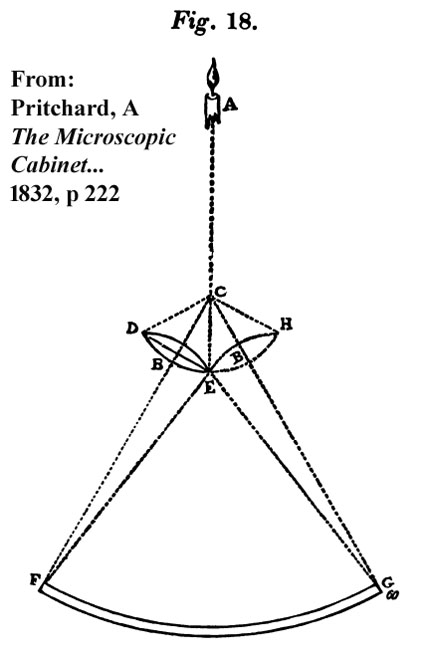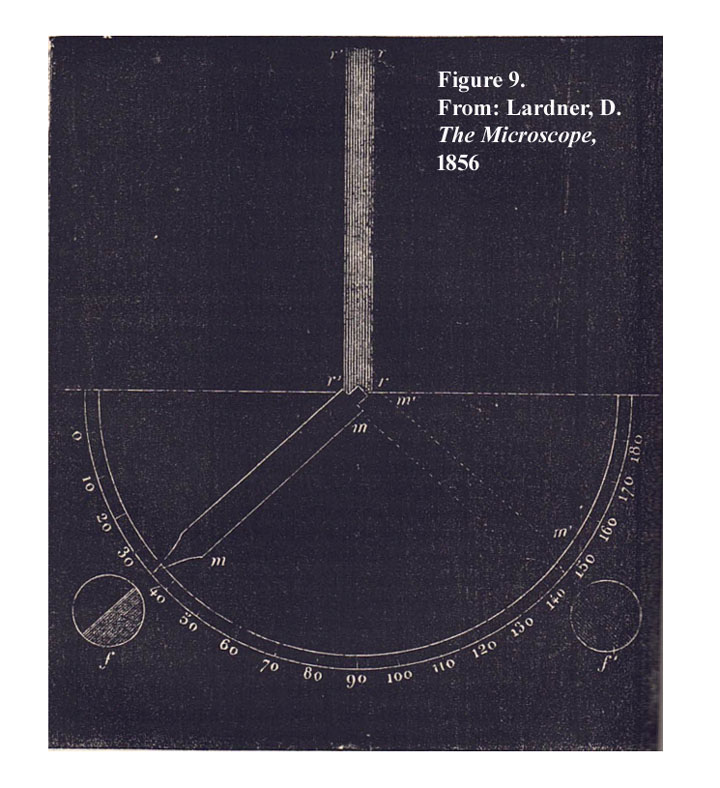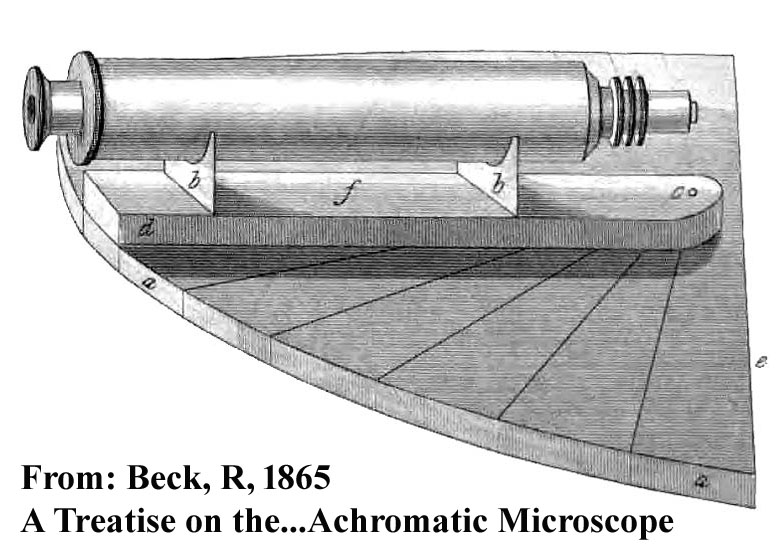MICROSCOPE APERTOMETER BODY TUBE
DATE: c. 1865
MAKER: probably Smith, Beck & Beck
AUTHOR AND COLLECTION OF: Jurriaan de Groot
INTRODUCTION
This page is about a rare example of Beck's apertometer body tube, as described and illustrated in Richard Beck's 1865 Treatise...the Achromatic Microscope. Prior to the development of specialized devices such as the Abbe apertometer, this method of measuring the angular aperture of microscope objectives
was for some time, the only one available, and worked only for dry objectives.
DESCRIPTION
The apertometer consists of a brass microscope body tube with an external diameter of 36.3 mm, and a length of 110 mm. There is a drawtube, which allows for the tube length to be extended to 215 mm. This has an internal diameter of 33.6 mm, and holds the eye piece, which has a magnification of 5X. This brass tube rests
horizontally on two semicircular wooden cradles, the weight bearing surfaces of which are covered in blue velvet. These are affixed to a longitudinal piece of mahogany,
which at one end is attached to a semicircular piece of wood, some 190 mm in radius, divided into degrees along its edge.The attachment point allows the tube and its mahogany support to rotate through an angle of 180 degrees, wherby the exact angle can be read with the assistance of a small brass pointer.
METHOD OF USE AND HISTORY
 The first description of this method of measuring the angular aperture of microscope objectives is found in Andrew Pritchard's The Microscopic Cabinet (1832),
and is attributed to Joseph Lister:
The first description of this method of measuring the angular aperture of microscope objectives is found in Andrew Pritchard's The Microscopic Cabinet (1832),
and is attributed to Joseph Lister: The principle of it may be seen in fig. 18. B represents the object-glass of an engiscope placed in a horizontal position, and C F
its axis, directed so far on one side of candle A, placed at a few yards distant, that the light of it shall bisect the field of view vertically, leaving half of it dark: then C being the focus of the object-glass, is to form a pivot, round which the body is to revolve horizontally to the other side of the candle till the opposite half of the field is illuminated as before, and the object-glass has arrived at the position denoted by the dotted lines (B), and the axis of the body into the line C G.
The space travelled over by the body from F to G is the angle of aperture in the present case equal to 60 degrees, for it is evident by construction that the angles D C E
and E C H are equal to the angle F C G made equal to 60 degrees
.
.
 Dionysius Lardner, in his The Microscope (1856) mentions, that:
Dionysius Lardner, in his The Microscope (1856) mentions, that: This method of ascertaining aperture was contrived and practiced by Mr Pritchard, at an early
epoch in the progress of the improvement of the microscope, when the importance of the angular aperture was demonstrated by that eminent artist and Dr Goring.
A similar description of the method follows, with an illustrative diagram.
 A more familiar description of this same method of measuring aperture is contained in Richard Beck's Treatise on the construction, proper use, and Capabilities of Smith,
Beck and Beck's Achromatic Microscopes (1865). The accompanying engraving (fig. 12)appears to show a device which is identical to the apertometer tube which features on
this page,and although unsigned, raises the possibility that this was made by Smith, Beck and Beck.
A more familiar description of this same method of measuring aperture is contained in Richard Beck's Treatise on the construction, proper use, and Capabilities of Smith,
Beck and Beck's Achromatic Microscopes (1865). The accompanying engraving (fig. 12)appears to show a device which is identical to the apertometer tube which features on
this page,and although unsigned, raises the possibility that this was made by Smith, Beck and Beck.
For a brief history of apertometers see our article on this site.
CONDITION
When purchased, the tube was in excellent condition, carrying most of its original lacquer. A 5X, 33.6 mm diameter eye piece was present, as well as a 1 1/2 inch objective in a non-matching cannister marked 2/3, Smith & Beck, 6 Coleman St, London
. Guided by Richard Beck's illustration, the present owner has created a replica mahogany carrier for the brass body tube as well as the 180 degree sector board, to resemble the original design as closely as possible.
BIBLIOGRAPHY
Beck, R. A Treatise on the Construction, proper use, and Capabilities of Smith, Beck, and Beck's Achromatic Microscopes. John van Voorst, Paternoster row, London. 1865
Lardner, D. The Microscope. Crosby Lockwood & Co, London. 1856
Pritchard, A. The Microscopic Cabinet of select animated Objects; with a description of the Jewel and Doublet Microscope, test objects, &c. London, Whittaker, Treacher,and Arnot, Ave-Maria-Lane. 1832.
 The first description of this method of measuring the angular aperture of microscope objectives is found in Andrew Pritchard's The Microscopic Cabinet (1832),
and is attributed to Joseph Lister:
The first description of this method of measuring the angular aperture of microscope objectives is found in Andrew Pritchard's The Microscopic Cabinet (1832),
and is attributed to Joseph Lister:  Dionysius Lardner, in his The Microscope (1856) mentions, that:
Dionysius Lardner, in his The Microscope (1856) mentions, that:  A more familiar description of this same method of measuring aperture is contained in Richard Beck's Treatise on the construction, proper use, and Capabilities of Smith,
Beck and Beck's Achromatic Microscopes (1865). The accompanying engraving (fig. 12)appears to show a device which is identical to the apertometer tube which features on
this page,and although unsigned, raises the possibility that this was made by Smith, Beck and Beck.
A more familiar description of this same method of measuring aperture is contained in Richard Beck's Treatise on the construction, proper use, and Capabilities of Smith,
Beck and Beck's Achromatic Microscopes (1865). The accompanying engraving (fig. 12)appears to show a device which is identical to the apertometer tube which features on
this page,and although unsigned, raises the possibility that this was made by Smith, Beck and Beck.